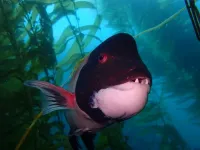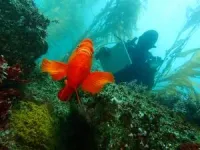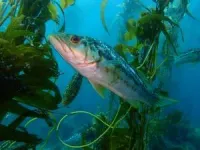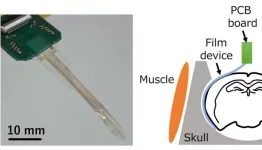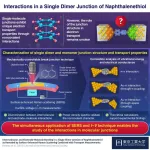(Press-News.org) (Santa Barbara, Calif.) – Rising ocean temperatures are sweeping the seas, breaking records and creating problematic conditions for marine life. Unlike heatwaves on land, periods of abrupt ocean warming can surge for months or years. Around the world these ‘marine heatwaves’ have led to mass species mortality and displacement events, economic declines and habitat loss. New research reveals that even areas of the ocean protected from fishing are still vulnerable to these extreme events fueled by climate change.
A study published today in Global Change Biology, led by researchers at UC Santa Barbara, found that while California’s network of marine protected areas (MPAs) provide many social and ecological benefits, they are not resilient to the effects of ocean warming. MPAs are locations in the ocean where human activities such as fishing are restricted to conserve and protect marine ecosystems, habitats, species and cultural resources. The study, part of a 10-year review of California’s MPA network conducted at UCSB’s National Center for Ecological Analysis & Synthesis (NCEAS), found that marine heatwaves impact ecological communities regardless of whether they are protected inside MPAs.
“MPAs in California and around the world have many benefits, such as increased fish abundance, biomass and diversity,” said Joshua Smith, who led the study while he was a postdoctoral researcher at NCEAS . “But they were never designed to buffer the impacts of climate change or marine heatwaves.”
Smith and co-authors from all over the world were part of an NCEAS working group formed to synthesize decades of long-term ecological monitoring data from California’s diverse ocean habitats. The group, co-led by Jenn Caselle, a researcher with UCSB’s Marine Science Institute, and Kerry Nickols, a professor from Cal State University Northridge who now works with the non-profit Ocean Visions, aimed to provide actionable scientific results to California’s policy makers and natural resource managers, as part of a statewide Decadal Evaluation of the MPA network. Their analyses spanned the largest marine heatwave on record, which rolled through the Pacific Ocean toward California from 2014-2016. The monster marine heatwave was formed from an environmental double-whammy – unusual ocean warming nicknamed “The Blob,” followed by a major El Niño event that prolonged the sweltering sea temperatures. The marine heatwave blanketed the West Coast from Alaska to Baja and left a wake of altered food webs, collapsed fisheries, and shifted populations of marine life among various other consequences.
As MPA managers around the world face increasing climate shocks, the extent to which MPAs can buffer the worst of these events has become an important question. The working group scientists asked how the ecological communities in California’s protected areas fared after such a severe and prolonged heatwave: Would the communities shift and if so, how? Would they ‘bounce back’ when the marine heatwave subsided? Could the marine protected areas protect sensitive populations or facilitate recovery?
To find answers to their questions, they synthesized over a decade of data collected from 13 no-take MPAs located in a variety of ecosystems along the Central Coast: rocky intertidal zones, kelp forests, shallow and deep rocky reefs. The team looked at fish, invertebrates and seaweed populations inside and outside these areas, using data from before, during and after the heatwave.
They also focused on two of these habitats, rocky intertidal and kelp forests, at 28 MPAs across the full statewide network to gauge whether these locations promoted one particular form of climate resilience — maintaining both population and community structure.
“We used no-take MPAs as a type of comparison to see whether the protected ecological communities fared better to the marine heatwave than places where fishing occurred,” said Smith, now an Ocean Conservation Research Fellow at Monterey Bay Aquarium.
The results are somewhat sobering, though not altogether unexpected.
“The MPAs did not facilitate resistance or recovery across habitats or across communities,” Caselle said. “In the face of this unprecedented marine heatwave, communities did change dramatically in most habitats. But, with one exception, the changes occurred similarly both inside and outside the MPAs. The novelty of this study was that we saw similar results across many different habitats and taxonomic groups, from deepwater to shallow reefs and from fishes to algae.”
The implication of these findings, according to Smith, is that every part of the ocean is under threat from climate change. “MPAs are effective in many of the ways they were designed, but our findings suggest that MPAs alone are not sufficient to buffer the effects of climate change.”
The key question now is what will happen in the future? At the time of this study using data through 2020, the ecological communities have not returned to their former, pre-heatwave state. According to the paper, these ecological communities shifted toward a “pronounced decline in the relative proportion of cold-water species and an increase in warm water species.” For example, increases in the abundance of the señorita fish (Oxyjulis californica), a subtropical species with warm water affinity and previously rare in central California, had an outsized influence on the shift of communities. Whether these species persist in their new locations remains to be seen.
“This study makes it clear why long-term monitoring of California’s MPAs is so critical,” said Caselle. “Some of these time series are longer than 25 years at this point and the data are critical to understanding and readying human communities for the changes occurring in our marine communities.” Continued study will show if future shifts in marine communities occur at different rates or to different base states in MPAs compared to fished areas.
Despite the limited ability of MPAs to resist the grip of the marine heatwave, they do confer benefits, not the least of which is the ability to study the complex effects of climate change in areas not impacted by fishing. As areas of minimal human interference that are regularly monitored, they present opportunities to study the response of marine ecosystems to shifting conditions and potentially tailor management techniques accordingly. Moreover, as Smith stated, “the ecological communities in MPAs are still being protected, even if they are different as a result of the heatwave. Given that marine heatwaves are anticipated to increase in frequency and magnitude into the future, swift climate action and nature-based solutions are needed as additional pathways to enhance the health of our oceans.”
Kerry Nickols adds, “With the devastating impacts of climate change already apparent, it is very important that we are upfront about climate solutions - as long as we are burning fossil fuels and warming the globe marine ecosystems will be at risk, even if they are protected from fishing.”
This paper is the first in a series led by the NCEAS working group. Forthcoming articles examine human engagement across the California MPA network, the effect of MPAs on fish populations and fisheries, and a synthesis of marine protected areas that work for people and nature.
END
Multiple ecosystems in hot water after marine heatwave surges across the Pacific
2023-07-13
ELSE PRESS RELEASES FROM THIS DATE:
When the stars align: Astronomers find answers to mysterious action of ghost stars in our Galaxy
2023-07-13
A collaboration of scientists from The University of Manchester and the University of Hong Kong have found a source for the mysterious alignment of stars near the Galactic Centre.
The alignment of planetary nebulae was discovered ten years ago by a Manchester PhD student, Bryan Rees, but has remained unexplained.
New data obtained with the European Southern Observatory Very Large Telescope in Chile and the Hubble Space Telescope, published in Astrophysical Journal Letters, has confirmed the alignment but also found a particular ...
Skin lightening products can be dangerous, but users don’t know risks
2023-07-13
· Colorism – system of inequality that views lighter skin as more beautiful and advantageous – motivates skin lightening
· Users aren’t aware of adulterated ingredients in over-the-counter products such as mercury and steroids
· Products are purchased from chain grocery stores or online, used without medical advice
CHICAGO --- Skin lightening is prevalent in the U.S. among skin of color individuals – particularly women – but the people who use those products don’t know the risks, reports a new Northwestern ...
Small-winged and lighter colored butterflies likely to be at greatest threat from climate change
2023-07-13
PRESS RELEASE FROM THE UNIVERSITY OF CAMBRIDGE
EMBARGOED UNTIL 05:01 LONDON TIME (GMT) ON THURSDAY 13 JULY 2023
Images and paper available at: https://drive.google.com/drive/folders/18XRYP9dHcC1Z8lc3B86j3k6BzgIesqUS?usp=sharing
Small-winged and lighter coloured butterflies likely to be at greatest threat from climate change
The family, wing length and wing colour of tropical butterflies all influence their ability to withstand rising temperatures, say a team led by ecologists at the University of Cambridge. The researchers believe this could help identify species whose survival is under threat from climate change.
Butterflies with smaller or lighter coloured wings are likely to ...
Unexpected coupling with leaky mode unveils new path for dense photonic integration
2023-07-13
Defying conventional wisdom, researchers have uncovered a novel coupling mechanism involving leaky mode, previously has been considered unsuitable for high-density integration in photonic circuits. This unexpected finding opens new possibilities for dense photonic integration, revolutionizing the scalability and application of photonic chips in optical computing, quantum communication, light detection and ranging (LiDAR), optical metrology, and biochemical sensing.
In a recent Light Science & Application publication, Sangsik Kim, associate professor of electrical engineering ...
Unemployment and underemployment significant drivers of suicide: Analysis
2023-07-13
A study examining unemployment and underemployment figures and suicide rates in Australia has found both were significant drivers of suicide mortality between 2004-2016.
The researchers say the findings indicate that economic policies such as a Job Guarantee, which prioritise full employment, should be a core part of any comprehensive national suicide prevention strategy.
Predictive modelling also revealed an estimated 9.5 percent of suicides reported during that time resulted directly from unemployment ...
Multisensory information detection by using multi-channel electrocorticography film that can place over a wide area of the cerebral cortex
2023-07-13
Overview
Associate Professor Hiroto Sekiguchi (Department of Electrical and Electronic Information Engineering, Toyohashi University of Technology) and Assistant Professor Susumu Setogawa and Associate Professor Noriaki Ohkawa (Comprehensive Research Facilities for Advanced Medical Science, Dokkyo Medical University; Assistant Professor Setogawa is currently a Specially Appointed Assistant Professor at University Public Corporation Osaka) have developed a flexible electrocorticography (Note 1) film for simultaneous detection of multisensory information (Note 2) from multiple regions of the cerebral cortex by placing neural ...
Fungi blaze a trail to fireproof cladding
2023-07-13
Mycelium, an incredible network of fungal strands that can thrive on organic waste and in darkness, could be a basis for sustainable fireproofing. RMIT researchers are chemically manipulating its composition to harness its fire-retardant properties.
Associate Professor Tien Huynh, an expert in biotechnology and mycology, said they’ve shown that mycelium can be grown from renewable organic waste.
“Fungi are usually found in a composite form mixed with residual feed material, but we found a way to grow pure mycelium sheets that can be layered and engineered into different uses – from flat panels for the building industry to a leather-like material for ...
Investigating interactions at molecular junctions for novel electronic devices
2023-07-13
The structure of a molecular junction with noncovalent interaction plays a key role in electron transport, reveals a recent study conducted by researchers at Tokyo Tech. Through simultaneous surface-enhanced Raman scattering and current–voltage measurements, they found that a single dimer junction of naphthalenethiol molecule shows three different bondings, namely π–π intermolecular and through-π and through-space molecule–electrode interactions.
The π–π interaction is a type of noncovalent interaction that occurs when the electron clouds in the π orbitals ...
Researchers report advance in immune therapy against ALS
2023-07-13
New research suggests that targeting autoimmune inflammation associated with amyotrophic lateral sclerosis (ALS) using two drugs, one of them already approved for multiple sclerosis, could be a promising approach for treatment.
ALS, also known as Lou Gehrig's disease, is a progressive neurodegenerative disease that affects the nerve cells in the brain and spinal cord. It leads to the gradual loss of muscle control, eventually resulting in paralysis and difficulty with speech, swallowing, and breathing. The exact cause of ALS is not fully understood, and currently, there is no cure ...
Taylor & Francis reduces plastic by introducing paperwrap for UK mailed journals
2023-07-13
Taylor & Francis has taken a significant step in reducing unnecessary plastic use with the introduction of paperwrap for journal print copies mailed in the UK.
Paperwrap, a relatively new packaging technology, has become more common in recent years, but is typically most suited to publications with very high print runs. Taylor & Francis’ Global Supplier Team spent several months investigating how it might be applied to journal print runs, which included rolling out live trial mailings to colleagues around the world to test how the journals could be packaged, and whether there was any impact on the speed ...
